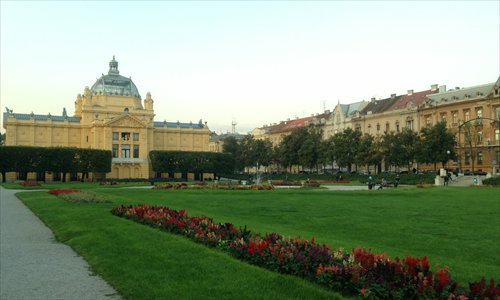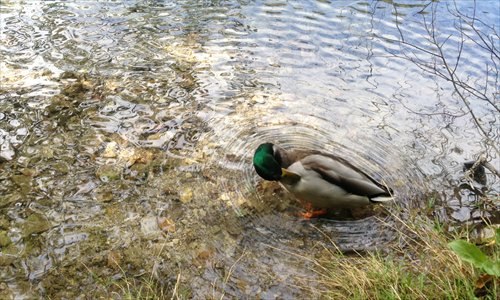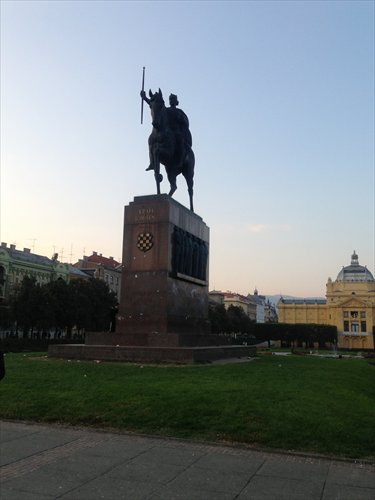Enchanting Zagreb

Art Pavilion Photo: Yang Zhenqi/GT

A mallard at Plitvice Lakes National Park. Photo: Yang Zhenqi/GT

A statue of King Tomislav in the square eponymously named after him. Photo: Yang Zhenqi/GT
A picturesque central European city with countless squares and splashes of color everywhere, from red rooftops to green and yellow buildings, Zagreb is a charming place to wander around on foot and enjoy the tranquility of the Croatian capital.
With beautiful cityscapes and cultural attractions rich in heritage, Zagreb does well to maintain its proud history, one that can be traced back to the 11th century. It is believed that the city grew out of two medieval settlements that had flourished for centuries on neighboring hills before it became the Croatian capital in the 16th century. Divided into old and new areas, the city's Upper Town serves as a reminder of the past, with remarkable old buildings of architectural wonder, while Lower Town embraces all that is modern without forgetting to maintain landmark historical sites.
Upper Town
Ban Jelacic Square and the Zagreb Cathedral are must visit attractions for tourists looking for a couple of spectacular sights right in the heart of town. Undisputed at the central focus of the capital, Ban Jelacic Square has been the commercial hub of the city since 1641, when it was a designated marketplace and key location for organized fairs.
Due to its impressive architecture, with a range of period buildings situated around the square - built from the 19th century and including post-modernism and nouveau art designs, the square continues to draw crowds of people today.
At the southern end of the square stands the Ban Josip Jelacic Monument, which remembers one of Croatia's noted army generals. The work of Austrian sculptor Anton Fernkorn, the statue was placed facing northwards on the square in 1866, to mark Jelacic's (1801-1859) defense of Croatia against Austria and Hungary during the Revolutions of 1848.
From there, head north to Kaptol Square, where Zagreb Cathedral, recognized for its slender 105-meter-tall twin towers that dominate the skyline, sits as one of the most popular landmarks in the capital.
Although its largely neo-gothic structure comes from the late 19th century, the cathedral's origins are much older as the construction of the building started shortly after the Zagreb bishopric was established in 1094. It now includes a Gothic sanctuary, a nave, a bell tower, and turreted walls, which were added in the following centuries. The neo-gothic influence came about from its reconstruction after a huge earthquake that destroyed most of the building in 1880, when the architectural style was very popular across Europe.
Visiting the cathedral at twilight is a nice way to share the experience with other tourists and devout Catholics, who will pack the area late into the night on a warm evening. With defensive walls around the cathedral, also featuring an imposing fountain and gold-plated statues of the Virgin Mary with Angels, the powerful visual site provokes an undeniable sense of holiness and magnificence.
Lower Town
Two of the city's best-loved public squares, Zrinjevac Square and King Tomislav Square, are a real treat. Zrinjevac Square is named after Nikola Subic Zrinski (1508-1566), the Croatian Ban who died defending Szigetvar, a Hungarian fortress besieged by the Ottoman Turks. Lined with trees imported from Italian coastal city Trieste, the enchanting garden-like promenade was a welcome change of pace from the busy city center.
Lovely fountains and busts of notable figures are arranged in the square, giving curious visitors enough to see as they stroll around. I was particularly drawn to "The Mushroom," or so Zagreb's first fountain is nicknamed, after its swelling shape. Designed by Austrian architect Herman Bolle with the intention of helping visitors keep cool on a sweltering summer day, it was built after the city opened its waterworks in 1878 and still sprays water at designated times every day.
To the south of Zrinjevac Square is King Tomislav Square. It was created to remember Tomislav, Croatia's first king who bravely defended continental Croatia from Hungarian attacks, and for the first time, united all Croatian lands into one country. Tomislav sought papal recognition and claimed the throne in 925. Though he died mysteriously three years later, his status as founding father of the Croatian state has since been emphasized.
An enormous statue of Tomislav on horse, made by Croatian sculptor Robert Franges Mihanovic, was placed in the middle of the square in 1947, and is now a picture-popular spot for tourists. With a collection of aesthetically pleasing museums, hotels and city halls around the area, the site offers plenty more for the architectural-focused eye.
Just north of King Tomislav Square, is the Art Pavilion, an art gallery housed in a stunning building, a personal favorite of mine that I highly recommend visitors make a stop at.
City escape
If you have the time, break from the city and head for the massive 290-square-kilometer Plitvice Lakes National Park, the country's first and largest national park established in 1949.
About a two-and-a-half hour drive out from Zagreb, the journey to one of the country's most popular tourist attractions, an honor it has had as a UNESCO World Heritage site since 1979, is well worth the travel.
The park holds an extraordinary number of waterfalls, gallery of lakes, forest and diverse wildlife, all of which are a feast for the eyes, but its most amazing wonder is its 16 peaceful lakes which were created by natural dams of travertine.
Hugged by never-ending forest and rejuvenated by fresh air and a sweet scent of plants, the lakes, renowned for their distinctive tones of green, grey and blue, all watered by a variety of springs from the Korana River, shimmer beautifully as the sun's rays reach down, helping to physically show the mood of the waters, changing their colors from deep shades to lighter hues of aqua blue-greens.
Dedicated pathways make for an enjoyable experience, while various activities, such as hiking programs, electric boat rides as well as cycling, skiing and rowing options are offered seasonally to those wanting a more engaging visit. Regardless of whether visitors make their way through the park on wheels or with hiking gear, the vast, natural beauty of this heavenly park is sure to please.
Rules of Thumb
How to go: There are currently no direct flights from Chinese mainland cities to Zagreb, but the Croatian capital is easily accessible from any major European city, including Moscow, Munich, Frankfurt, London, Paris and Vienna.
When to go: Zagreb can get quite hot in the summer, but springtime temperatures are very comfortable, making this season the perfect time for a visit. Fall is also nice, but generally rainier than spring. Winter in the city can feel quite wet, especially by December, so dress warmly if you plan a trip here for Christmas.
Where to stay: Catering to a mix of travelers, the Croatian capital offers budget, comfort and luxury hotels. For greater convenience to major attractions, stay at the center of either Upper Town or Lower Town.